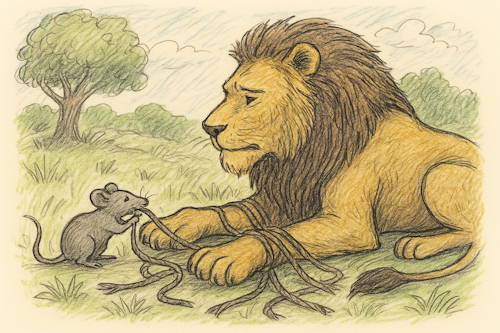The Lion & The Mouse
Illustrates Psychological Safety, Respect, Empowerment
Agile success depends not only on strong frameworks and tools, but also on trust, humility, and mutual support. These are not soft qualities, they are foundational. Leaders often look for strength in bold moves and loud voices, but strength also lies in listening, in caring, and in recognizing that even the smallest voice can spark the biggest change.
The classic Aesop fable, The Lion and the Mouse1, gives us a simple but powerful metaphor for the dynamics of psychological safety, inclusive leadership, and team trust.

One day, a mighty lion lay napping in the sun. A tiny mouse, scurrying through the grass, accidentally ran across the lion's nose. With a roar, the lion awoke and trapped the mouse beneath his massive paw.
“Please let me go,” begged the mouse. “Someday, I may be able to help you.”
The lion laughed. “You? Help me? I am king of beasts! What help could I ever need from a mouse?”
But he released the mouse anyway.
Days later, the lion found himself caught in a hunter's net. He struggled, roared, and thrashed, but the ropes held firm.
Hearing the lion's cries, the mouse returned. With quick teeth, she gnawed through the net and set the lion free.
“I did not think it possible,” the lion said quietly. “But I see now, kindness and courage can come in any size.”
Lessons Learned
Never Underestimate Quiet Strength
The lion assumed the mouse was weak because she was small. In Agile organizations, the loudest or most senior voice often gets the spotlight, while quieter team members are overlooked. Yet insight, innovation, and support often come from unexpected places. Agile thrives when all voices are valued.
Psychological Safety Unlocks Potential
The lion's act of mercy, though initially patronizing, created safety. When the lion needed help, the mouse returned without fear. In Agile teams, safety empowers people to step up, take action, and contribute beyond their roles. Safety is not about comfort, it is about courage without fear of punishment.
True Strength Includes Humility
The lion's transformation, from scoffing to grateful, shows the power of humility. In Agile leadership, this humility is critical. When leaders admit they don't have all the answers, they invite collaboration and create space for shared ownership.
Empowerment Builds Reciprocity
The mouse was not ordered or forced to help the lion. She acted from gratitude and purpose. Empowerment invites this kind of reciprocity. When team members feel respected and trusted, they are more likely to go above and beyond. Control creates compliance. Respect fuels commitment.
Help Can Come From Anywhere
Agile coaches know that solutions don't always come from the top. Sometimes the best product insights come from a support agent or an intern. Wise teams cultivate the habit of listening broadly and inviting contributions from every corner.
Coaching Tips
- Use this Story to Challenge Assumptions: Invite teams to reflect on who might be overlooked in decision-making and why. What voices are missing in Sprint Reviews or Retrospectives?
- Illustrate Psychological Safety: Share the parable during a workshop or team launch and ask, “What would keep the mouse from helping?” This opens up honest conversations about fear, status, and inclusion.
- Encourage Gratitude Rituals: Like the mouse, many Agile team members quietly step up for each other. Create moments to recognize contributions, even the small ones. Appreciation builds team resilience.
The lion learned what every Agile leader must eventually accept: that strength is not about dominance, it is about connection. And the smallest act of trust can lead to the greatest outcomes.
If your team is stuck in hierarchy or silence, the first step may be to look down and listen closely. Help might be closer than you think.


